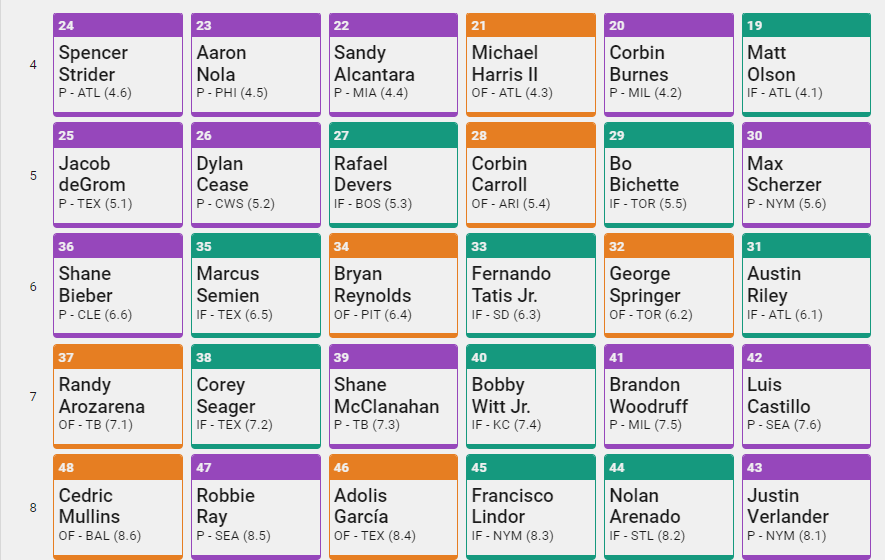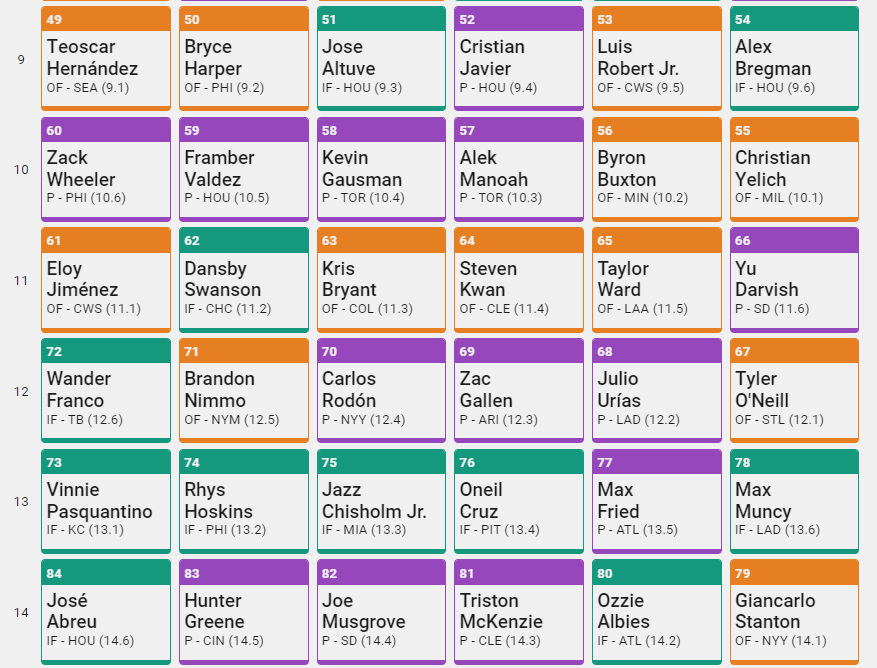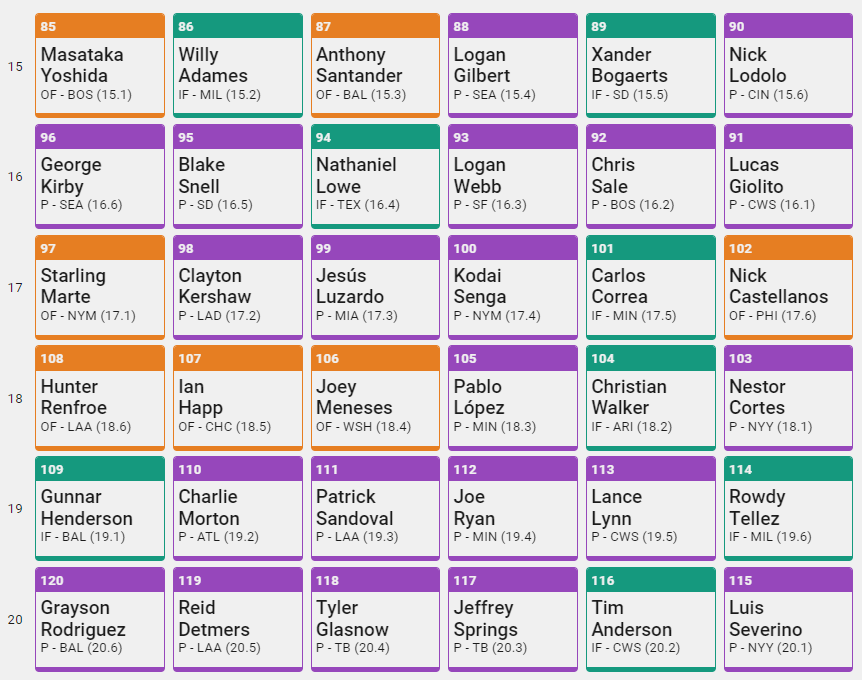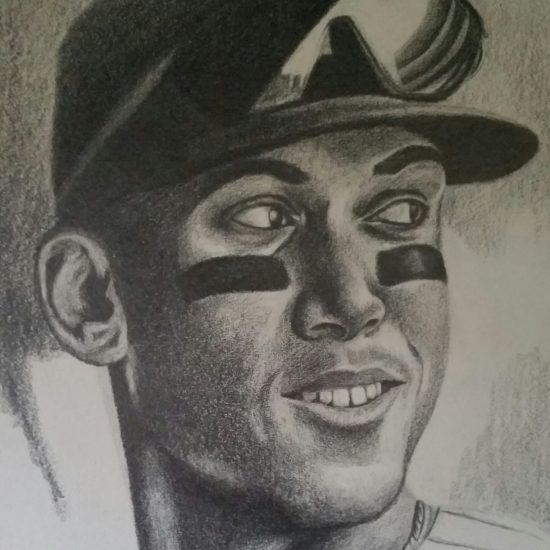This is a sponsored post from Underdog Fantasy. Sign up today with promo code PITCHERLIST to get 100% of your deposit matched up to $100.
One of the many contests offered on Underdog, Best Ball is somewhere in between DFS and season-long in that you’re not drafting a new team every day, and you don’t have to agonize over starts and sits. It’s a great format if you’d rather not commit to managing a season-long team, yet still find yourself eager to draft a roster. There’s no waiver wire or injured list to manage. Once you draft your team, you’re done- that’s it.
Scoring
Rosters consist of three IF, three OF, one FLEX, three pitchers, and ten bench players. In Best Ball, your highest-scoring roster is tallied every week. Everything is added up at the end of the season, with the top three teams typically finishing in the money in twelve-team contests.
Note that Underdog does have projections listed for every player, but here I’ll refer to the projections on Pitcher List.
Rounds 1-3

Unlike our previous two drafts, this one was six teams with the top two teams finishing in the money. I drew the last pick and did what I had been doing in 12-teamers, and went with outfielders Shohei Ohtani and Mookie Betts. But in hindsight, I think I made a mistake by not going with Freddie Freeman instead of Betts. It might be splitting hairs, but the PL projections have Freeman ahead and as we’ll see later, the small player pool really alleviates the OF problem found in standard 12-team drafts. Evidently, Nick Pollack, who picked second, was thinking the same thing I was at first and took it a step further by drafting Kyle Schwarber as his third OF.
Gerrit Cole was the first pitcher off the board at pick 17 (3.5) which started an avalanche in the next round.
Rounds 4-8

After I kicked off the fourth with Matt Olson, six of the next seven picks were pitchers. Having gone with four bats in a row, I finally capitulated to the pitching wave and took Max Scherzer to end the fifth.
In standard-sized season-long formats, Jacob deGrom’s ranking has been a point of contention based on injury risk. Here, he went off the board as the sixth SP. I think this is the perfect format for him. With his skills so far ahead of the field, and the player pool so condensed, it becomes less about fretting over total innings and more about just taking the pitcher who has the highest ceiling start-to-start.
Full disclosure, I’ve only done three Best Ball drafts so far, but one takeaway from them is that Corbin Caroll seems overvalued right now. The NL RoTY favorite went at 5.4 here as the 12th OF off the board; The PL projections have him as the 33rd OF. I understand chasing after the SB upside in category formats, but here in a points league, I wonder if he’s getting pushed up a little too much.
Conversely, Bryan Reynolds might be a smidge undervalued right now. The PL projections have him as the 11th OF by total points. But here he went 13 picks after Michael Harris II, who the projections have as the 14th OF.
Rounds 9-14

I ended the ninth by drafting Alex Bregman as my fifth hitter. He’s terrific in any sort of points format and has the same total points protection as Bobby Witt Jr. who came off the board 14 picks earlier in round seven.
In the eleventh round, I took Yu Darvish as my fourth pitcher. With Carlos Rodón looking like he might not miss much time, he was a tempting target but I couldn’t pass on Darvish who last year finished second in baseball behind Framber Valdez with 28 QS.
In the 12th-14th round, I picked boom/bust home run hitters Tyler O’Neill, Max Muncy, and Giancarlo Stanton.
Rounds 15-20

Fueled by a devastating hook that returned a 21% SwStr% rate, Nick Lodolo’s K rate of just under 30% gives him the upside that makes him an easy target in all fantasy formats. Even better, in Best Ball, we can ignore any potential blow-up starts he might have while pitching in a notoriously hitter-friendly home park.
One pick I might’ve done differently if we played this out again was Lucas Giolito in the 16th round. Similar to deGrom, I think Clayton Kershaw gains value in this shallow format where you don’t have to worry as much about total innings and instead you can focus more on just what pitcher has the highest ceiling start-to-start. Kershaw was still one of the most efficient pitchers in baseball with a 23.1% K-BB%, just behind Justin Verlander for 13th among all starters with a minimum of 100 IP.
In previous drafts, I’ve mentioned avoiding late-round hitters like TJ Friedl, Jake Fraley, Adam Duvall, and Garrett Mitchell because I’m not extremely confident in their playing time. But here we didn’t have to worry about that. For bench hitters, I emphasized hitters with home run upside, in which case Rowdy Tellez seemed like a perfect fit as he should have some big weeks against RHP.
I ended the draft taking an eighth SP in Luis Severino. A few picks later, Nick Pollack stayed very much on brand with one of his favorite breakouts, Reid Detmers.
It did feel strange seeing C.J. Cron still on the board; His power bat is well-suited to this format, especially when the Rockies are on a homestand. That brings up the interesting question of what’s more valuable: an eighth SP or another bench hitter. Initially, I leaned towards the extra bat given the nature of hitting week-to-week, plus you can only start three pitchers a week. Although, on the flip side, the extra pitcher gives you another way to cash in on potential two-start weeks, so it’s an interesting debate and another example of the different ways to approach the format.

